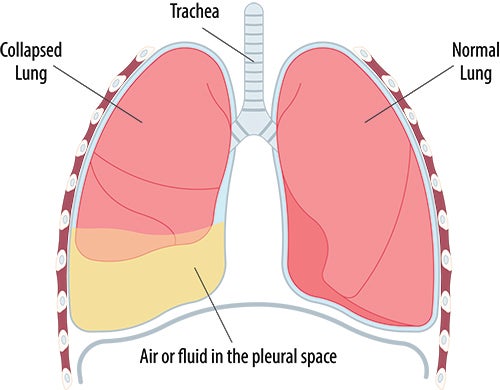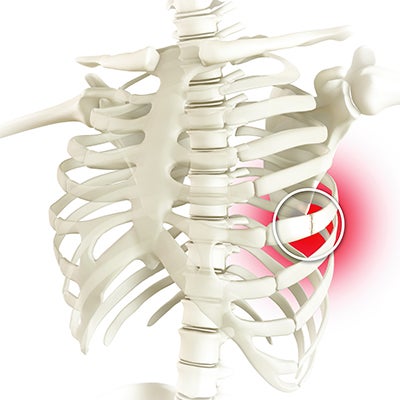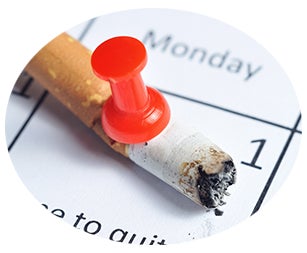Chest Injuries
Chest injuries can occur from a wide range of activities, especially car accidents. Driving at high speeds and not wearing a seatbelt increases your risk of a chest injury.
Your provider may diagnose a chest injury with:
- Chest X-ray
- Computed tomography (CT) scan
- Ultrasound
- Blood pressure, pulse and oxygen levels.
Some common types of chest injuries (and their treatment) include:
Pneumothorax (collapsed lung)
 Accumulation of air between the lung and the chest wall leading to partial or complete collapse of the lung
Accumulation of air between the lung and the chest wall leading to partial or complete collapse of the lung
Common causes:
- Falls
- Motor vehicle collisions
Treatment:
- Treatment varies depending on the amount of air accumulated.
- It can resolve without any intervention or may require a chest tube or surgery.
Rib Fracture (broken/cracked rib)
Common causes:
- Falls
- Motor vehicle collisions
 Common symptoms:
Common symptoms:
- Sharp, localized pain to the injury site
- Pain with deep breaths/coughing
Treatment:
- Early mobilization is key to preventing further complications like pneumonia — this includes walking and taking deep breaths.
- Pain relievers are indicated, as needed.
Pulmonary contusion (lung bruise)
Common symptoms:
- Shortness of breath
- Pain with deep breaths
Treatment:
- Pain control is important.
- Deep breathing exercises with an incentive spirometer may be used.
- Some patients may need supplemental oxygen.
Incentive spirometer (IS)
Device that helps you take deep breaths to help prevent complications such as pneumonia.
How to use
- Stretch out tubing then attach the mouthpiece. Connect to the base as shown in the image.
- Sit upright in a chair and hold the device at eye level
- Close you mouth tightly around the mouthpiece
- Take a deep of a breath as you are able (the piston should rise in the device)
- Once you get the indicator as high as you can, hold that deep breath for 10 seconds
- Breathe out slowly for 10 seconds and take a break
- Repeat 10 times!
 Smoking
Smoking
Smoking plays a major role in how your body heals after an injury. What should you do if you want to quit smoking? It's a good idea to start by talking with your doctor or nurse. It is possible to quit on your own, without help. But, getting help greatly increases your chances of quitting successfully.
When you are ready to quit, make a plan to:
- Set a quit date.
- Tell your family and friends that you plan to quit.
- Plan ahead for the challenges you will face, such as cigarette cravings.
- Remove cigarettes from your home, car and work.
Quitline NC
- 1-800-QUIT-NOW (1-800-784-8669)
- 1-855-Déjelo-Ya (1-855-335-3569)
- www.quitlinenc.com
- Text READY to 200-400 to enroll via text.
- Visit us on Facebook @QuitlineNC.
